CSS margin knowledge points
1.Percentage value of margin
The percentage maigin of ordinary elements is calculated relative to the width (width) of the container element.
Here we set a container with a width and height of 800 * 600 outside the image. Set img{ margin: 10%; }
The results are as follows
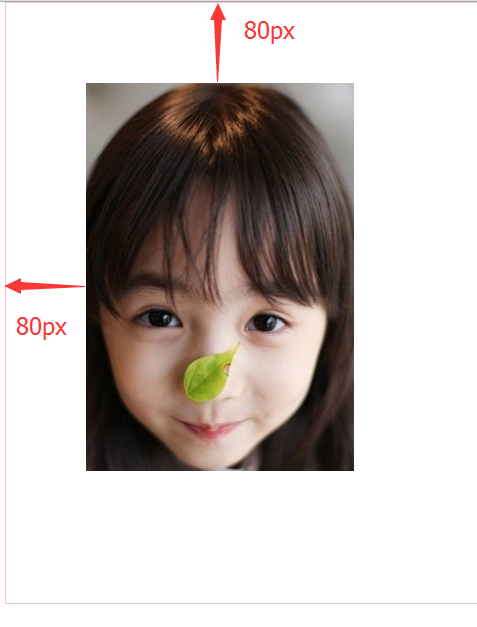
The resulting margin values are all 800 * 10% = 80px; so here they are calculated relative to the width of the container. The width of the container is calculated. The width of the container is calculated . Say it three times
2. Percentage maigin value of absolute positioning



It is calculated relative to the width value of the first positioned ancestor element of . That’s parent’s width = 1000px. So margin = 100px;
3. You can use margin to achieve 2:1 adaptation
For example, there are two containers


The height of the box here is not specified. Due to setting margin 50%. Its height is half of the parent container, so the aspect ratio is 1:2;

4. Why do margins overlap?
A) Two overlapping characteristics of margin
Only happens on horizontal elements of block. (excluding float and absolute elements)
Ignoring wirte-mode (that is, writing format), only occurs in the vertical direction (margin-top margin-bottom)
B) What happened
1> Adjacent sibling elements
2> The first and last child element of the parent
3> Empty block.
Example 1 Adjacent sibling elements

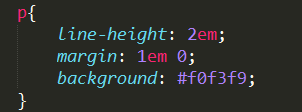
Here are two brother elements.
 There is only one em between the two p here, not two em. Because the first margin-bottom and the second margin-top overlap.
There is only one em between the two p here, not two em. Because the first margin-bottom and the second margin-top overlap.
Example 2 The parent element and the last child element overlap

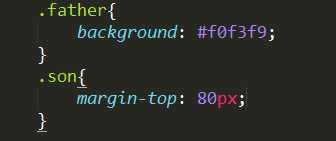
According to conventional theory, a margin-top value of 80px will be left between son and father of the parent element. But it doesn't. The background element of son has not changed and no 80px is left;
Here we just set 80px for the parent element;

Conditions for parent-child margin overlap
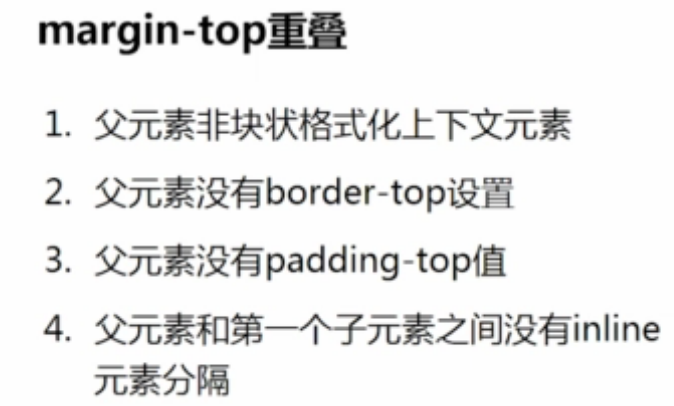
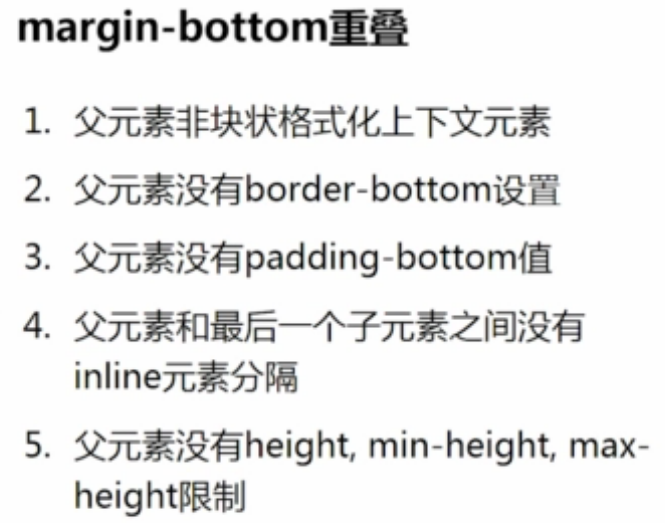
So how to get rid of margin-top overlap?
As long as it doesn’t meet those conditions.
The parent element adds overflow: hidden; border-top padding-top (add a space between them);
Example 3: The margins of empty block elements overlap.
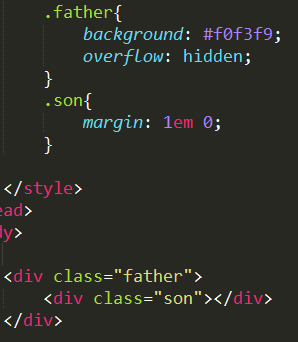

Note that there is an empty element with no content inside . Conditions for margin overlap of empty elements
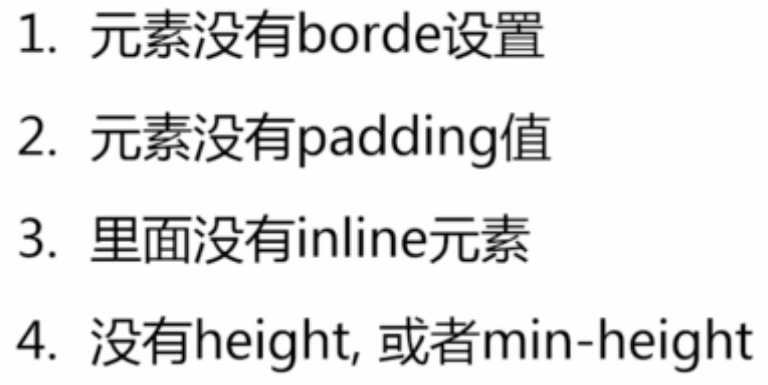
4 Calculation rules for margin overlap.
A) Take the maximum positive value
B) Adding positive and negative values
C) Take the most negative number.
5. The meaning of margin overlap
A) Continuous paragraphs or lists, etc., if there is no margin overlap and the ending appears 1:2, it will appear uncoordinated
B) Nesting or placing divs directly anywhere in the web will not affect the original layout
C) Any missing empty p elements should not affect the original reading layout
Practical Application
When making lists, control the
in the distance of each list 
.list{
margin-top: 15px;
margin-bottom: 15px;
}
More robust, even if the last one is removed, the layout will not be affected

Hot AI Tools

Undresser.AI Undress
AI-powered app for creating realistic nude photos

AI Clothes Remover
Online AI tool for removing clothes from photos.

Undress AI Tool
Undress images for free

Clothoff.io
AI clothes remover

Video Face Swap
Swap faces in any video effortlessly with our completely free AI face swap tool!

Hot Article

Hot Tools

Notepad++7.3.1
Easy-to-use and free code editor

SublimeText3 Chinese version
Chinese version, very easy to use

Zend Studio 13.0.1
Powerful PHP integrated development environment

Dreamweaver CS6
Visual web development tools

SublimeText3 Mac version
God-level code editing software (SublimeText3)

Hot Topics
 1666
1666
 14
14
 1425
1425
 52
52
 1328
1328
 25
25
 1273
1273
 29
29
 1253
1253
 24
24
 HTML: The Structure, CSS: The Style, JavaScript: The Behavior
Apr 18, 2025 am 12:09 AM
HTML: The Structure, CSS: The Style, JavaScript: The Behavior
Apr 18, 2025 am 12:09 AM
The roles of HTML, CSS and JavaScript in web development are: 1. HTML defines the web page structure, 2. CSS controls the web page style, and 3. JavaScript adds dynamic behavior. Together, they build the framework, aesthetics and interactivity of modern websites.
 The Future of HTML, CSS, and JavaScript: Web Development Trends
Apr 19, 2025 am 12:02 AM
The Future of HTML, CSS, and JavaScript: Web Development Trends
Apr 19, 2025 am 12:02 AM
The future trends of HTML are semantics and web components, the future trends of CSS are CSS-in-JS and CSSHoudini, and the future trends of JavaScript are WebAssembly and Serverless. 1. HTML semantics improve accessibility and SEO effects, and Web components improve development efficiency, but attention should be paid to browser compatibility. 2. CSS-in-JS enhances style management flexibility but may increase file size. CSSHoudini allows direct operation of CSS rendering. 3.WebAssembly optimizes browser application performance but has a steep learning curve, and Serverless simplifies development but requires optimization of cold start problems.
 The Future of HTML: Evolution and Trends in Web Design
Apr 17, 2025 am 12:12 AM
The Future of HTML: Evolution and Trends in Web Design
Apr 17, 2025 am 12:12 AM
The future of HTML is full of infinite possibilities. 1) New features and standards will include more semantic tags and the popularity of WebComponents. 2) The web design trend will continue to develop towards responsive and accessible design. 3) Performance optimization will improve the user experience through responsive image loading and lazy loading technologies.
 HTML vs. CSS vs. JavaScript: A Comparative Overview
Apr 16, 2025 am 12:04 AM
HTML vs. CSS vs. JavaScript: A Comparative Overview
Apr 16, 2025 am 12:04 AM
The roles of HTML, CSS and JavaScript in web development are: HTML is responsible for content structure, CSS is responsible for style, and JavaScript is responsible for dynamic behavior. 1. HTML defines the web page structure and content through tags to ensure semantics. 2. CSS controls the web page style through selectors and attributes to make it beautiful and easy to read. 3. JavaScript controls web page behavior through scripts to achieve dynamic and interactive functions.
 HTML: Building the Structure of Web Pages
Apr 14, 2025 am 12:14 AM
HTML: Building the Structure of Web Pages
Apr 14, 2025 am 12:14 AM
HTML is the cornerstone of building web page structure. 1. HTML defines the content structure and semantics, and uses, etc. tags. 2. Provide semantic markers, such as, etc., to improve SEO effect. 3. To realize user interaction through tags, pay attention to form verification. 4. Use advanced elements such as, combined with JavaScript to achieve dynamic effects. 5. Common errors include unclosed labels and unquoted attribute values, and verification tools are required. 6. Optimization strategies include reducing HTTP requests, compressing HTML, using semantic tags, etc.
 HTML vs. CSS and JavaScript: Comparing Web Technologies
Apr 23, 2025 am 12:05 AM
HTML vs. CSS and JavaScript: Comparing Web Technologies
Apr 23, 2025 am 12:05 AM
HTML, CSS and JavaScript are the core technologies for building modern web pages: 1. HTML defines the web page structure, 2. CSS is responsible for the appearance of the web page, 3. JavaScript provides web page dynamics and interactivity, and they work together to create a website with a good user experience.
 HTML: Is It a Programming Language or Something Else?
Apr 15, 2025 am 12:13 AM
HTML: Is It a Programming Language or Something Else?
Apr 15, 2025 am 12:13 AM
HTMLisnotaprogramminglanguage;itisamarkuplanguage.1)HTMLstructuresandformatswebcontentusingtags.2)ItworkswithCSSforstylingandJavaScriptforinteractivity,enhancingwebdevelopment.
 From Text to Websites: The Power of HTML
Apr 13, 2025 am 12:07 AM
From Text to Websites: The Power of HTML
Apr 13, 2025 am 12:07 AM
HTML is a language used to build web pages, defining web page structure and content through tags and attributes. 1) HTML organizes document structure through tags, such as,. 2) The browser parses HTML to build the DOM and renders the web page. 3) New features of HTML5, such as, enhance multimedia functions. 4) Common errors include unclosed labels and unquoted attribute values. 5) Optimization suggestions include using semantic tags and reducing file size.




